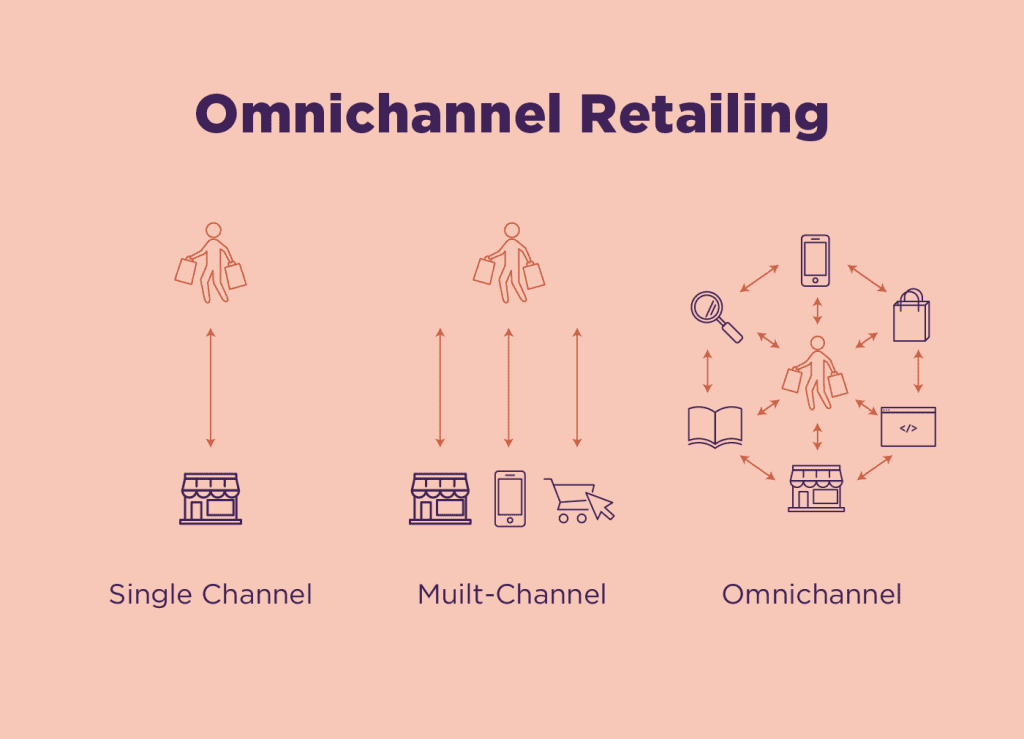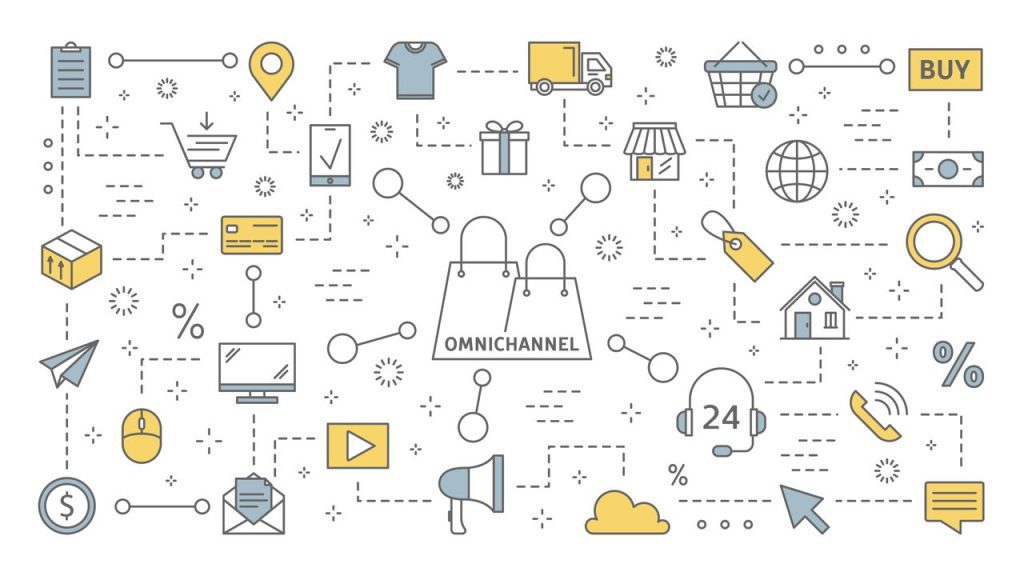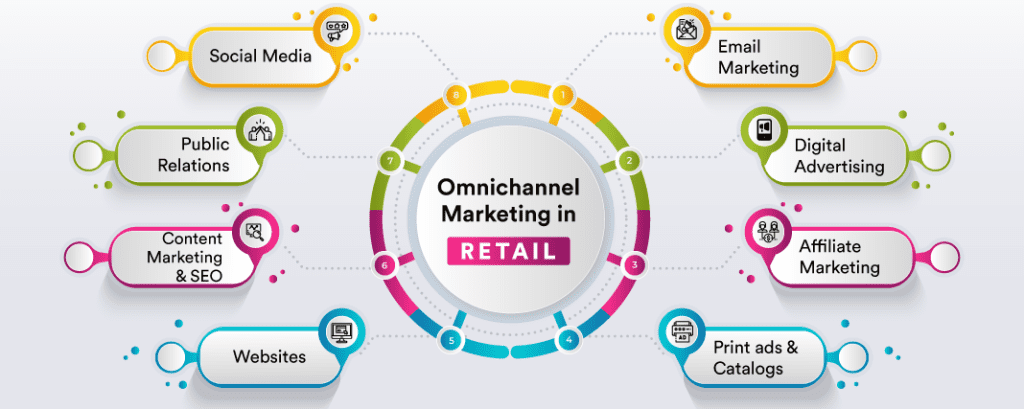The vast majority of online merchants begin with a single sales channel, such as a website or marketplace.
Buyers, on the other hand, have a plethora of touchpoints and purchasing options, necessitating store diversity.
Omnichannel retailing is the practice of selling things through various sales channels.
The idea is to broaden your reach beyond your website to include marketplaces, social media, and comparison shopping engines.

What is omnichannel retail?
Omnichannel retailing is defined as transacting over multiple channels such as marketplaces, social media, and physical stores.
The term “omnichannel” has become a buzzword, but it’s more than a fancy way of saying “I sell across multiple channels.” Let’s take a look at the nuanced distinctions between omnichannel, multi-channel, and single-channel commerce.
To meet your customers where they are and create relationships that cross channels, a genuine omnichannel approach must give a consistent brand experience everywhere you sell. It should also place a strong emphasis on growing your business by diversifying your channels and fully integrating your data and technology.
Multi-channel commerce, like omnichannel, refers to the sale of goods across multiple channels.
Multi-channel experiences, on the other hand, are frequently inconsistent as a result of siloed marketing efforts with no clear cross-channel message. Multi-channel theories focus on optimizing by touchpoint rather than by route.
“While organizations may be tempted to focus on refining specific touchpoints, expecting that the total will be greater than the sum of its parts,” McKinsey analysts write, “such targeted intervention might aggravate discrepancies in service and inconsistencies in other encounters.”
Unlike omnichannel and multichannel merchants, other retailers prefer to sell through a single channel. Some suppliers have their own ecommerce stores, while others use third-party marketplaces such as Amazon.
In October 2022, eMarketer raised its projection for online retail sales growth in 2022 from 20% to 30%.
According to a poll, buyers of all ages shop across several sales channels.
According to a consumer survey conducted in the United States:
– Seventy-four percent went to big-box stores to shop.
– Ecommerce marketplaces were used by 54% of those surveyed.
– 44 percent of shoppers used online stores.
– Online stores that specialize in a specific category accounted for 36% of all sales.
Single-channel loyalty is a thing of the past.
Take, for example, Amazon Prime Day.
Given that the event is exclusive to Prime members, most people assume that the extra traffic will benefit only Amazon sellers.
According to a BazaarVoice research, 76 percent of Prime Day shoppers plan to shop around before completing an Amazon purchase.
Customers who shop on Amazon also look at prices and reviews on other websites. They’re curious about:
– Walmart is a store that sells a variety of goods (46 percent )
– Consumer electronics-related websites (45 percent )
– Home improvement-related websites (39 percent )
– Websites for businesses (39 percent ).
Omnichannel retailers who implement a good diversification plan will expand their reach as well as their sales potential.
Related Reading: Contextual Commerce – The Future in Digital-Centric Ecommerce
What are the types of omnichannel strategies?
Consumers have become multi-channel shoppers, and retailers must now understand each channel type in order to determine its value.
Different channels are required at different stages of the buyer’s journey.
1. Social media platforms
Using social media, people can discover new items and stores.
Influencers share their tales every day, and sponsored pieces can drive traffic, if not sales.
On Instagram and Pinterest, you can tag items for purchase, and this trend is only growing.
You should use social media to engage and create relationships with your clients, even if you’re a branded merchandise reseller or distributor.
2. Your shopping cart and website.
For all types of stores, an online store is essential since it allows you to customize and personalize the shopping experience.
A website can be used to deliver educational content that answers user questions and attracts new visitors.
Email marketing can also be used for lead nurturing and brand advocacy.
Related Reading: Shoppable Media – What is it and how it leverages social commerce
3. Shopping comparison engines.
Price and convenience are the two most essential factors in purchase decisions.
Comparison shopping tools such as Google Shopping, Shopzilla, and PriceGrabber provide shoppers with rapid pricing information.
As a vendor, you can bid on traffic as part of your paid advertising strategy.
4. Shopping malls.
Customers at the consideration and decision stages of the purchase process, when they are ready to buy and have a specific brand or product in mind, can benefit from marketplaces.
There are vertical, horizontal, and global marketplaces, each with its own set of categories and levels of assortment.
Consumers are discovering firms in new ways these days, and they’re searching for new conveniences to aid them in their purchasing decisions. This article will show you how to combine your online and offline channels, as well as all of your operations, to deliver a consistent and comprehensive experience across all touchpoints.
According to Sharon Gee, BigCommerce’s General Manager, Omnichannel, COVID-19 has “motivated everyone to function at a considerably higher level of digital maturity.” “Today, businesses must stake a position and create a unified channel strategy from both a digital and physical perspective in order to succeed.”

However, switching from offline to online channels was not the only alteration in behavior.
Consumers chose different products and services than usual, tried new brands or merchants, and shopped with new restrictions, such as finding stores that offer curbside pickup or delivery.
“Marketers noticed a new type of client behavior, and if they did their homework, they learnt something new about them,” said Andrew Kandel, Waze’s North American head of sales. “Normalcy will return, but an enlightened client who sees the world in a new perspective will emerge.”

What are the benefits of omnichannel retailing?
Multi-channel commerce enables you to communicate with your customers regardless of where they are in the purchasing process or which device they prefer.
Now that purchasers have mobile devices, there are no limits to where they can find and buy things.
1. Reach out to customers at different phases of the purchasing process.
In multi-channel retailing, the buyer’s journey is important.
Unless they’re in a rush, most buyers who see your product for the first time aren’t ready to buy.
The majority of customers like to browse, read reviews, and compare costs.
In the age of free shipping, 2-day shipping, and ship-to-store alternatives, customers can afford to wait.
Understanding the buyer’s journey and employing a multi-channel strategy will set you apart from the competition.
At the top of the funnel, consumers may learn about your product through social media, such as an Instagram influencer or a Pinterest image.
Affiliate marketing and educational content that answers user questions can help bring in new customers to your store.
Other clients may not be looking for a specific product and are just looking for help with an issue, such as how to clean a carpet stain or what to wear to a specific event.
Buyers will be aided in their decision-making process if your website, blog, or product descriptions have excellent SEO.
Customers who are ready to purchase will most likely go to marketplaces or comparison shopping engines.
In fact, while shopping for a product, more than half of buyers choose Amazon over Google.
These websites not only provide traffic, but also a level of trust through peer reviews.
Related Reading: Ecommerce Analytics: Leveraging Data To Unlock Online Sales
2. Make use of marketplaces and search engines to your advantage.
Merchants are caught in the crossfire as Amazon, Walmart, eBay, and even Google compete for online market dominance.
A single-channel vendor may suffer if one company dominates the other, whereas multi-channel suppliers have greater freedom and flexibility.
Artificial intelligence is the most important element to look for when it comes to customer insights from multi-channel retailing.
These online behemoths are all seeking to personalize clients’ purchasing experiences by assisting them in locating the appropriate goods at the right time.
From marketplace algorithms to better search results, multi-channel commerce allows you to use technology to help your products be found.
The issue of trust is another incentive to look at marketplaces and comparison shopping engines.
Apart from bogus reviews, most customers use these sites because of their reputation and the availability of product ratings and peer reviews.
Indeed, 65 percent of buyers polled by DigitalCommerce360 said they were comfortable purchasing from marketplace third-party suppliers they had never heard of.
Kilowott empowers companies from across the retail and ecommerce sector, to offer everything from online webstores to tracking solutions that can bolster online selling of your products.
Need help? Let’s talk






